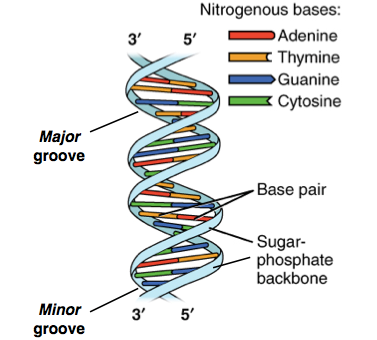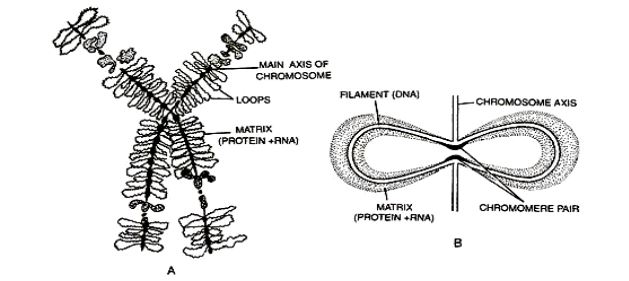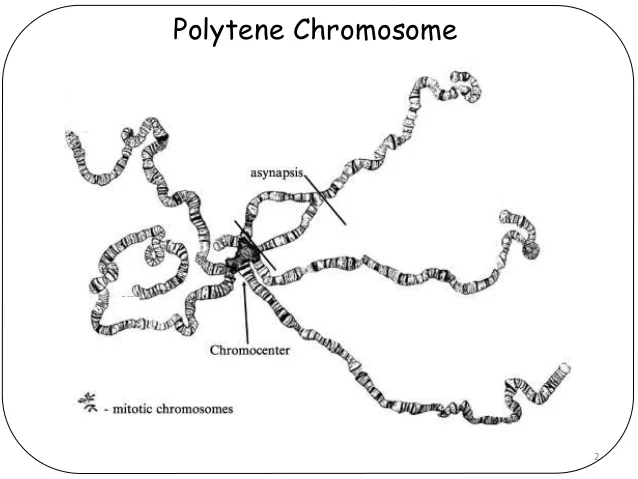
Chapter 4: DNA, Chromosomes, and Genomes
DNA, Chromosomes and Genomes
The hereditary information which is stored in every individual and passed on to future generations is in the form of genes. Units of inheritance are called genes.
DNA was thought of as a structural element but, after a few experimental observations, it was proved that DNA is the genetic material.
Evidence from bacterial transformation: Two strains of bacterium Streptococcus pneumonia were taken.
S strain: Smooth or capsulated type which has a mucous coat and produces smooth shiny colonies.
R strain: Rough or non-capsulated type which has don’t have a mucous coat and produces rough colonies.
It was concluded from the experiment that the transforming principle or substance controls genetic characteristics.
Wilkins and Franklin studied DNA molecules with the help of X-ray crystallography. With the help of this study, Watson and Crick proposed the double helical DNA structure. James Watson and Francis Crick double helical structure of DNA solved a lot of queries related to the technicalities of genetic transmission.
Structure of DNA:
DNA is an acidic substance present in the nucleus and was first identified by Fredrick Mischer.
DNA is a long polymer of deoxyribonucleotides.
DNA is negatively charged.
In DNA, pentose sugar is deoxyribose, and four types of nitrogen bases are A, T, G, and C.
According to the DNA model, DNA is composed of two polynucleotide chains.
Both polynucleotide chains are complementary and antiparallel to each other.
In both strands of DNA direction of the phosphodiester bond is opposite.
In one strand of DNA, polarity is 5’ → 3’ and in the other strand polarity is 3’ → 5’.
Both strands of the DNA are held together by hydrogen bonds. These hydrogen bonds are present between the nitrogen bases of both strands.
Adenine binds to thymine by two hydrogen bonds and cytosine binds to guanine by three hydrogen bonds.
In a DNA molecule, one purine always pairs with a pyrimidine. This generates an approximately uniform distance between the two strands of the DNA helix.
In the DNA plane one base pair stack over the other in a double helix. This, in addition to H-bonds, confers additional stability to the helical structure of DNA.

DNA Packaging in Prokaryotes:
DNA is found in the cytoplasm in the supercoiled state. The coils are maintained by nonhistone proteins like polyamines. This compact structure of DNA is called nucleoid or genophore.
DNA Packaging in Eukaryotes:
It is carried out with the help of lysine and arginine-rich basic proteins called histones.
The unit of compaction is the nucleosome.
There are five types of histone proteins H1, H2A, H2B, H3, and H4, called the core of the nucleosome.
The negatively charged DNA is wrapped around the positively charged histone octamer to form a structure called a nucleosome.
A typical nucleosome contains 200 bps of DNA helix.
DNA present between two adjacent nucleosomes is called linker DNA. It is attached to histone protein. The length of linker DNA varies from species to species.
The packaging at a higher level requires an additional set of proteins (acidic) that collectively are referred to as non-histone (NHC) proteins.
In a typical nucleus, some regions of chromatin are loosely packed and are referred to as euchromatin.
The chromatin that is densely packed and stains dark is called heterochromatin.
Euchromatin is said to be transcriptionally active, and heterochromatin is transcriptionally inactive.
Key terms:
Chromosome:
Rodlike structure
Heredity vehicle (as it carries DNA which passes on to next generation
A condensed form of chromatin
Chromatin: It is a complex of DNA and proteins that form chromosomes within the nucleus of eukaryotic cells.
Karyotype: Study of external morphology which includes size, shape, number, arm length, and secondary constriction.
Homologous chromosome: Homologous chromosomes are two pieces of DNA within a diploid organism that carry the same genes, one from each parental source.
Heterologous chromosome: A heterologous chromosome is a chromosome that contains a different set of genes for a given trait.
Exons: Exons encode sections of an RNA transcript, or the DNA encodes
it, that is translated to protein.
Introns: An intron is any nucleotide sequence within a gene that is removed by RNA processing ensuring the final RNA product.
Epigenetic Inheritance: Epigenetic inheritance is an unconventional finding. It goes against the idea that inheritance happens only through the DNA code that passes from parent to offspring. It means that a parent's experiences, in the form of epigenetic tags, can be passed down to future generations.
Each DNA molecule that forms a linear chromosome must contain a centromere, two telomeres, and replication origins.
Chromosome undergoes a series of processes collectively called the cell cycle.
After DNA replication, the presence of a second specialized DNA sequence called a centromere, allows one copy of each duplicated and condensed chromosome to be pulled into each daughter cell when a cell divides.
The third specialized DNA sequence forms telomeres, the ends of a chromosome.
A piece of chromosome that is normally euchromatic can be translocated into the neighborhood of heterochromatin. Remarkably, this often causes silencing (inactivation) of the normally active genes. This phenomenon is called a position effect.
Unique Chromosomes:
Lampbrush chromosome:
The largest chromosome known.
It is seen in the oocytes of some vertebrates like amphibians.
It is seen in the oocytes of females, especially in the diplotene stage of meiosis where it turns into a series of large chromatin loops.

Polytene chromosomes:
Found in an unusual class of cells of flies, like drosophila.
Here somatic pairing is seen when mitosis occurs, but the anaphase phase is not completed.

Chapter 4: DNA, Chromosomes, and Genomes
DNA, Chromosomes and Genomes
The hereditary information which is stored in every individual and passed on to future generations is in the form of genes. Units of inheritance are called genes.
DNA was thought of as a structural element but, after a few experimental observations, it was proved that DNA is the genetic material.
Evidence from bacterial transformation: Two strains of bacterium Streptococcus pneumonia were taken.
S strain: Smooth or capsulated type which has a mucous coat and produces smooth shiny colonies.
R strain: Rough or non-capsulated type which has don’t have a mucous coat and produces rough colonies.
It was concluded from the experiment that the transforming principle or substance controls genetic characteristics.
Wilkins and Franklin studied DNA molecules with the help of X-ray crystallography. With the help of this study, Watson and Crick proposed the double helical DNA structure. James Watson and Francis Crick double helical structure of DNA solved a lot of queries related to the technicalities of genetic transmission.
Structure of DNA:
DNA is an acidic substance present in the nucleus and was first identified by Fredrick Mischer.
DNA is a long polymer of deoxyribonucleotides.
DNA is negatively charged.
In DNA, pentose sugar is deoxyribose, and four types of nitrogen bases are A, T, G, and C.
According to the DNA model, DNA is composed of two polynucleotide chains.
Both polynucleotide chains are complementary and antiparallel to each other.
In both strands of DNA direction of the phosphodiester bond is opposite.
In one strand of DNA, polarity is 5’ → 3’ and in the other strand polarity is 3’ → 5’.
Both strands of the DNA are held together by hydrogen bonds. These hydrogen bonds are present between the nitrogen bases of both strands.
Adenine binds to thymine by two hydrogen bonds and cytosine binds to guanine by three hydrogen bonds.
In a DNA molecule, one purine always pairs with a pyrimidine. This generates an approximately uniform distance between the two strands of the DNA helix.
In the DNA plane one base pair stack over the other in a double helix. This, in addition to H-bonds, confers additional stability to the helical structure of DNA.

DNA Packaging in Prokaryotes:
DNA is found in the cytoplasm in the supercoiled state. The coils are maintained by nonhistone proteins like polyamines. This compact structure of DNA is called nucleoid or genophore.
DNA Packaging in Eukaryotes:
It is carried out with the help of lysine and arginine-rich basic proteins called histones.
The unit of compaction is the nucleosome.
There are five types of histone proteins H1, H2A, H2B, H3, and H4, called the core of the nucleosome.
The negatively charged DNA is wrapped around the positively charged histone octamer to form a structure called a nucleosome.
A typical nucleosome contains 200 bps of DNA helix.
DNA present between two adjacent nucleosomes is called linker DNA. It is attached to histone protein. The length of linker DNA varies from species to species.
The packaging at a higher level requires an additional set of proteins (acidic) that collectively are referred to as non-histone (NHC) proteins.
In a typical nucleus, some regions of chromatin are loosely packed and are referred to as euchromatin.
The chromatin that is densely packed and stains dark is called heterochromatin.
Euchromatin is said to be transcriptionally active, and heterochromatin is transcriptionally inactive.
Key terms:
Chromosome:
Rodlike structure
Heredity vehicle (as it carries DNA which passes on to next generation
A condensed form of chromatin
Chromatin: It is a complex of DNA and proteins that form chromosomes within the nucleus of eukaryotic cells.
Karyotype: Study of external morphology which includes size, shape, number, arm length, and secondary constriction.
Homologous chromosome: Homologous chromosomes are two pieces of DNA within a diploid organism that carry the same genes, one from each parental source.
Heterologous chromosome: A heterologous chromosome is a chromosome that contains a different set of genes for a given trait.
Exons: Exons encode sections of an RNA transcript, or the DNA encodes
it, that is translated to protein.
Introns: An intron is any nucleotide sequence within a gene that is removed by RNA processing ensuring the final RNA product.
Epigenetic Inheritance: Epigenetic inheritance is an unconventional finding. It goes against the idea that inheritance happens only through the DNA code that passes from parent to offspring. It means that a parent's experiences, in the form of epigenetic tags, can be passed down to future generations.
Each DNA molecule that forms a linear chromosome must contain a centromere, two telomeres, and replication origins.
Chromosome undergoes a series of processes collectively called the cell cycle.
After DNA replication, the presence of a second specialized DNA sequence called a centromere, allows one copy of each duplicated and condensed chromosome to be pulled into each daughter cell when a cell divides.
The third specialized DNA sequence forms telomeres, the ends of a chromosome.
A piece of chromosome that is normally euchromatic can be translocated into the neighborhood of heterochromatin. Remarkably, this often causes silencing (inactivation) of the normally active genes. This phenomenon is called a position effect.
Unique Chromosomes:
Lampbrush chromosome:
The largest chromosome known.
It is seen in the oocytes of some vertebrates like amphibians.
It is seen in the oocytes of females, especially in the diplotene stage of meiosis where it turns into a series of large chromatin loops.

Polytene chromosomes:
Found in an unusual class of cells of flies, like drosophila.
Here somatic pairing is seen when mitosis occurs, but the anaphase phase is not completed.

 Knowt
Knowt
